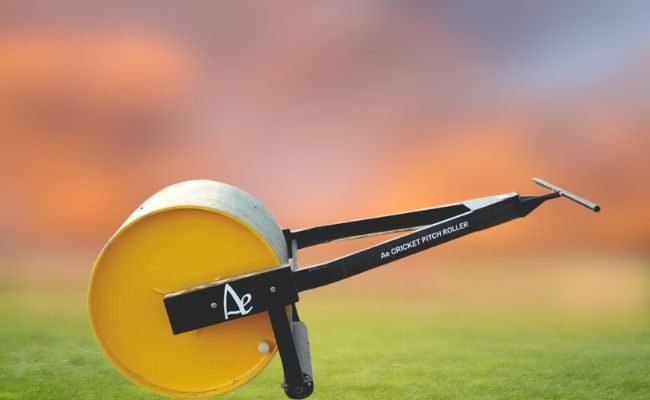The Art of Rolling: Cricket Groundsman's Secrets for a Perfect Pitch
Cricketers need precision, skill, and constant practice. But the playing ground also needs precision, skill, and consistency. One of the most indispensable tools for a high-quality pitch maintenance is a cricket pitch roller. It will level off the playing field, guarantee consistent bounce, and ensure an optimal pitch condition for matches. But how do you determine the frequency of using a cricket pitch roller to maintain its quality? We will, therefore, delve into expert advice on pitch rollers, maintenance, and best practices on keeping your cricket pitch in top condition in this blog.
What is a Cricket Pitch Roller?

A cricket pitch roller is an appliance used to compact the soil that forms a cricket field to provide an even and smooth playing surface. It’s usually utilized before and after matches to flatten the pitch and make a firm base for consistent bounce and better behavior of the ball.
There are different types of pitch rollers, including manual and motorized models. The most common rollers are heavy, cylindrical machines that are either pulled or powered by a tractor. They help in the preparation of the pitch surface before the game, as well as post-match to repair and recover any damage caused by play.
Why Is a Cricket Pitch Roller Important?

The condition of the pitch is important to the overall performance of a cricket match. A poorly maintained pitch can cause inconsistent bounce, cracks, and unpredictable movement, which affects the quality of play for both batsmen and bowlers.
Cricket pitch roller is used regularly, and there are several benefits:
- Consistency: It ensures that the surface remains flat, allowing for even bounce.
- Durability: It reduces wear and tear by compacting the surface and preventing cracking.
- Ball Behavior: Helps in creating conditions where the ball behaves predictably, thus making the game all the more enjoyable and fairer.
- Aesthetic Appeal: A well-rolled pitch, professionally approached, is very appealing for both players and spectators.
How Frequently Should One Use Cricket Pitch Roller?

The frequency of usage depends on several factors, such as weather conditions, the type of pitch, and the level of play. Following are some general guidelines about how to use a cricket pitch roller:
1. Before the Match:
Before the game, a cricket pitch roller is used to make the surface smooth and compact. According to the weather conditions and the pitch’s condition, you need to roll more than once in a single round.
In the case of rolling the pitch on the day before the match, the ground should be allowed to settle and compact fully before play. Heavy rollers will do their work at this stage by compressing the soil beneath to produce a firm pitch.
Light Roll: Just before the match, a light roll smoothes out any imperfections and compacts the surface. This is to ensure that the pitch doesn’t get too hard and remains playable.
2. During the Match:
In professional cricket, the pitch is usually rolled between innings to ensure that any damage caused by the game is repaired. This helps in maintaining the pitch’s quality throughout the day.
Mid-Game Roll: After the first innings, the cricket pitch roller can be used to repair any damage to the pitch, such as divots or wear caused by bowlers and batsmen. The roller should be used lightly to prevent overcompaction.
3. After the Match:
When the game is over, the pitch would have gathered several impressions. Rolling the pitch post-match helps to rectify the stress caused on the surface by repair it before the next game.
Recovery Roll: After the match, compact the soil in the pitch with the roller to fill cracks or indentations that could have emerged due to the playing of the game. Upon settlement and hardening, such a surface is ready for use.
4. Weather Conditions:
The kind of weather will also determine how frequently you should roll the cricket pitch. For instance, dry weather can make the soil crumbly and thus create cracks. The rolling should be more frequent to maintain the smoothness and minimize cracking.
On the other hand, during rainy weather, the pitch may become mushy. Rolling the pitch right after rain can damage the playing surface. Therefore, it is necessary to wait for the right amount of moisture to roll the pitch. Generally, it is preferred to lightly roll the pitch after the rain to avoid muddy spots.
How Much Rolling Is Too Much?

Although it is understood that the cricket pitch roller should be rolled as frequently as possible, rolling too much can cause several adverse effects. Excessive rolling tends to make the soil compacted and may make grass or vegetation difficult to grow, leading to a hard surface that does not give in enough to offer minimal bounce to the game.
One should ensure not to overdo it with a cricket pitch roller. Frequent use, especially after each game, might lead to a hard pitch, which doesn’t allow the ball to behave as it is expected to. On the other hand, less rolling would give an uneven pitch, causing bounce inconsistencies and poor playability.
Type of Pitch Matters
Different types of pitches have to be treated differently. For instance:
- Turf Pitches: These require frequent rolling to compact the surface and maintain even bounce. However, these pitches need to be rolled with caution in order not to damage the grass cover.
- Artificial Pitches: These are more robust and require less rolling. Still, it is essential to roll them occasionally to keep the surface smooth and free from damage.
Best Practices for Maintaining a Cricket Pitch with a Roller

To maximize the effectiveness of your cricket pitch roller and maintain your pitch in excellent condition, consider the following best practices:
- Roll at Consistent Intervals: Regular rolling is crucial for maintaining an even surface. Stick to a rolling schedule and avoid overdoing it, especially in the lead-up to a match.
- Use the Right Weight Roller: The weight of the pitch roller determines much about the pitch condition. Use a lighter roller for fine-tuning and a heavier roller for compaction.
- Check Soil Moisture Levels: Before using the roller, always check the moisture levels of the pitch. If the soil is too dry or too wet, the roller won’t perform effectively. A damp surface is the best for effective operation.
- Avoid Rolling Over Wet Spots: When the pitch is still too soft or wet after rainfall, do not roll over those spots. This can cause your pitch to become uneven.
- Allow for Rest Periods: Your cricket pitch, just like your players, needs rest periods. Avoid continuous rolling without giving the pitch a chance to rest between sessions.
Conclusion
The use of a cricket pitch roller is essential in order to preserve a quality playing surface for cricket. Whether one is preparing to play, repairing post-game damage, or just getting the pitch ready between matches, the proper maintenance of a pitch is of utmost importance in allowing for an even game to be played.
At Ae Sports, we are aware of the need to maintain your cricket pitch. We have high-quality pitch rollers that will help keep your pitch smooth, compact, and ready for action with regular maintenance using the right equipment. You will always achieve excellent results for professional matches and friendly games.
